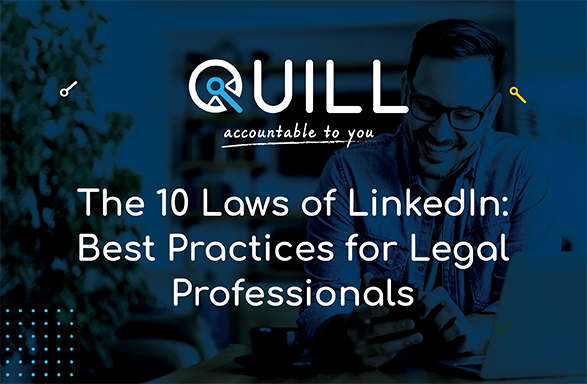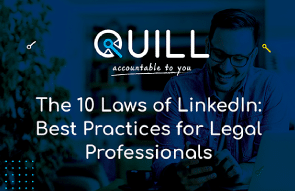By Legal Futures Associate Quill
This article is based on learnings from hosting our most recent Quill Uncovers webinar: LinkedIn for law: A step by step guide for partners. This webinar featured guest speakers Yvonne Boateng, Sahar Farooqi and Stuart Kaye, who shared some of their learnings about LinkedIn.
Here at Quill, we like to think of our combination of legal software and services as your law firm’s best friend. But there’s a second-best friend on the block, one which law firms are turning to more and more often.
It’s called LinkedIn.
LinkedIn is a social media platform built on the values of personality and professionalism, which is what makes it perfect for any aspiring law firm to stamp its mark on an increasingly competitive digital world. It can help you find new clients, advertise your business and search for talented new hires all under one roof, and all for free.
But although around 94% of lawyers are using LinkedIn, not all of them are using it well.
That’s why we’ve put together the Ten Laws of LinkedIn, so that you can do it better.
Watch the webinar recording here:
Law #1 – Focus on YOU
First things first, you need to be prepared to put yourself in the spotlight. Yes, it’s important for your law firm to have its own company page, but remember that people connect with people, not logos. Posts from personal accounts exhibit much higher levels of engagement than those from company pages, so make the most of what the LinkedIn algorithm is giving you.
Equally, you don’t want your company page to look like it’s gathering dust. Although your main focus should be on growing your own individual network, be sure to keep your company page ticking over by resharing content from yourself and the rest of the team through it.
Law #2 – Put a face to the name
It sounds simple, but adding a professional image to your profile is absolutely essential. Put on your best smile, because LinkedIn reports that using a professional profile picture makes your profile 14 times more likely to be viewed by others. Accompanying this with a branded cover photo will also help build a positive connection between your face and your brand.
Your LinkedIn profile is basically the first impression you’re going to make with new connections and prospective clients. Make sure that when people arrive at your profile, they have a reason to stay there.
Law #3 – Grab the headlines
There are over 770 million users on LinkedIn, and your headline is your best opportunity to tell people what makes you different from every other lawyer on the platform. Couple this with a well-written, personalised About section and you’re much more likely to stand out from the crowd.
When writing your headline and bio, put yourself in the shoes of someone who is looking at your profile for the first time. What do they want to know about you? How can you help them? Why are you special? Your profile is just as much about them as it is about you.
Law #4 – Build your network
LinkedIn is something of a popularity contest, but that doesn’t mean you need to start sending connection requests to anyone and everyone. It’s worthless having thousands of connections if only a few of them are actually interested in what you have to say.
Instead, build your network slowly and steadily. Start with people you know, and then branch out to anyone you think you will have a mutually beneficial relationship with. When you connect with someone, anything you post will automatically go to the top of their feed, so try to curate your posts around their specific interests to get things off to a great start.
Law #5 – Get engaged
Share the love before you start sharing content. The more you put into the LinkedIn platform, the more it will give back, so be sure to engage with a few posts a day. A ‘like’ is good, but if you can add value to someone’s post through a comment, that’s even better!
Remember, you get what you give, and the best way to make people engage with you is to engage with them first. Just remember to be friendly and professional in your interactions – even if it’s just a comment. Anything you say will be held against you, so be constructive, not antagonistic!
Read more at https://www.legalfutures.co.uk/associate-news/the-10-laws-of-linkedin-best-practices-for-legal-professionals





